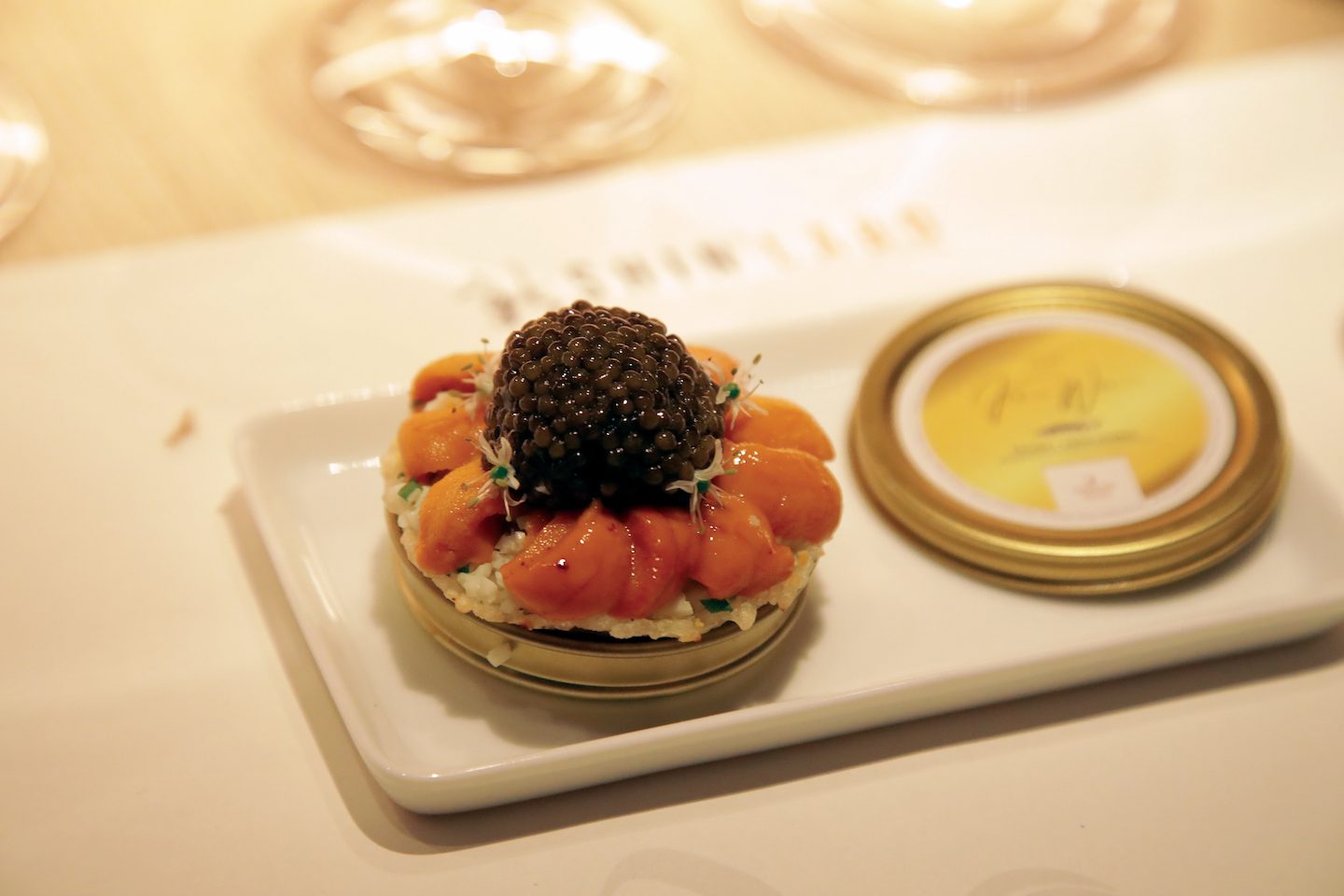
The Caviar & Uni tart, with the precious roe as the core and tangerine-hued sea urchin as petals (All photos: Louis XIII)
For as long as our palates can remember, the amalgam of cuisines has come to mean that food is neither one thing nor another; that the marriage of culinary cultures can sometimes lead into dubious territory. Yet, the omurice — soft-set omelette draped over rice — at Shin’Labo upends this outmoded impression about fusion and offers a positive momentum in that genre. Here, the beloved mainstay of Japanese home cooking has been reimagined as an éclair-shaped amuse bouche, wrapped in chicken skin to mimic fried rice and embellished with a crème of egg yolk as well as egg white. It turns out that a meal, in the hands of the skilled, can be a moveable feast that transcends geographical and gastronomical boundaries.
It is possible that Western food has lodged itself within the imagination of Japanese chefs more than the Americans or the French think. There is even a legitimate term that describes this awareness: yoshoku, a cooking style that reshapes Euro-centric dishes to cater for Japanese tastes. During Japan’s Meiji Restoration, its citizens were deployed to the West to glean knowledge about modern science, weaponry, laws and technology. Startled by how much shorter they were than their strapping counterparts, the Japanese vowed to catch up with them economically, and physically, by consuming what they ate.
b_1226.jpg
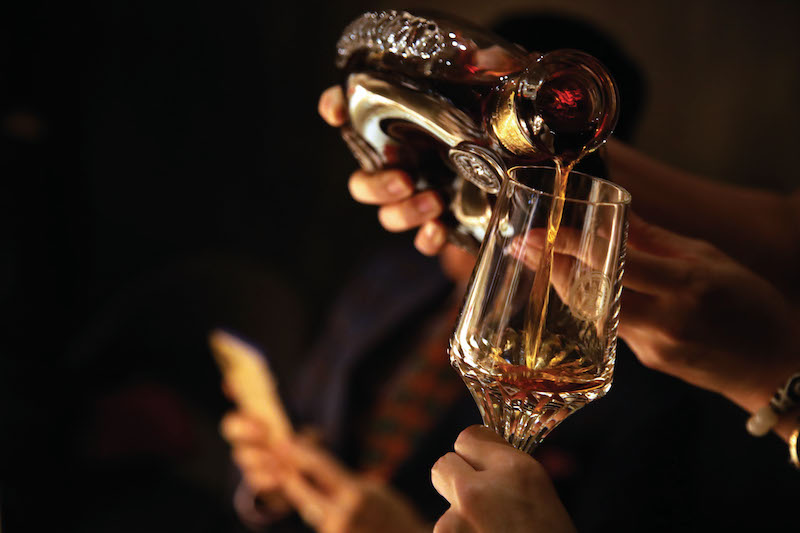
Thus began the proliferation of anglicised dishes in the country, from the ketchup-coated Italian Napolitan spaghetti and the American hambagu (burger served without the bun and covered with demi-glace) to curry, a staple borrowed from India and favoured among British naval officers in the 19th century. The latter eventually became the popular kare eaten in homes and school cafeterias across the island.
So commonplace has yoshoku become that elevated versions of it have seeped into the fine-dining scene. Although alien to Western culinary ideals in appearance and flavours, this Japanese adaptation proves that the quintessence of Western classics, given enough care and curation, can be achieved through Asian ingredients. In fact, said triumph can already be found on our shores: James Won’s latest venture Shin’Labo at Lalaport in Bukit Bintang City Centre, Kuala Lumpur has dreamt up a stage to promote its brand of Japanese-French cooking, with indigenous local ingredients as its primary cast.
If Won’s earlier Gallic endeavour, Enfin, focused on the haute, Shin’Labo stems from the heart. In case you are wondering, the name is derived from the Japanese word shin, which translates into “heart”, “true” or “new”; while labo — meaning laboratory in both French and Japanese — resonates with the experimental nature of the restaurant. Together, both concepts conjure up a playground of novel ideas, set in a modish space shrouded in utmost privacy. Just last week, in the spirit of adventure, it partnered with Louis XIII in a pairing dinner that showcased two of life’s sybaritic splendours: cognac and caviar.
b_0203.jpg
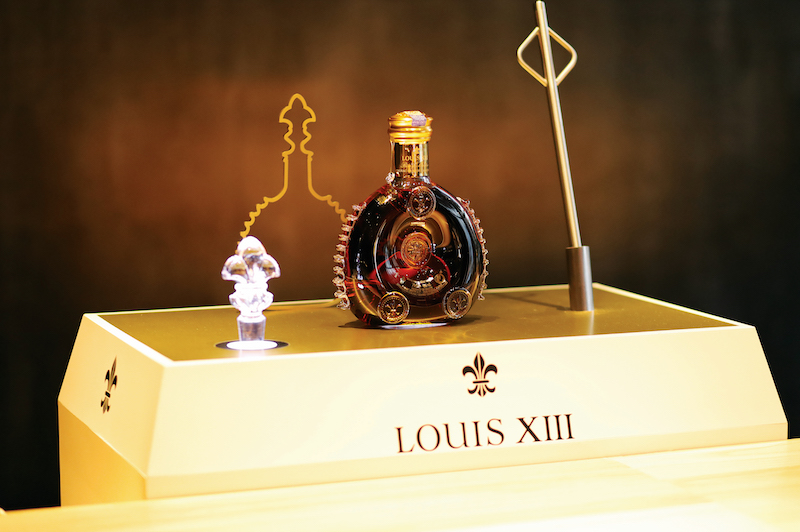
To partake of a multi-course meal accompanied by a wine list is to explore a spectrum of dining possibilities. But spirits, like Rémy Martin’s most prized cognac that accommodates deep thirsts and deeper pockets, are trickier as most are better suited to be enjoyed alone. There are always exceptions, of course. As demonstrated at Shin’Labo, Louis XIII’s warm hues of mahogany — characteristic of eaux-de-vie that have been aged for many years — run in stride with the brininess of caviar, sourced from a Kaluga-Amur sturgeon hybrid. Arranged like the core of a sunflower on a flat rice crisp, with tangerine-hued creamy uni as petals, the precious roe was carefully selected by Won in collaboration with Tanjung Malim-based caviar farm T’lur.
This Caviar & Uni tart was just one of the many highlights artfully paraded throughout the multi-course experience held in the restaurant’s Shin’Kappou room. Although most diners are familiar with the refined dining ritual of kaiseki, kappou — a cooking style founded in Osaka — is a less formal undertaking that emphasises the proximity between the diner and the chef. Thus, seats are aligned against the table at just the right height for Asian diners so they can be entertained and educated comfortably at the same time.
Every clink of tableware that landed before us was a reveille, a call to sit up and pay attention to the transporting series of entrées and mains about to appear. The procession of starters — which included a sashimi platter of raw tuna sandwiched between cured hamachi (amberjack), Hokkaido scallop seared in uni butter, and lightly battered tempura fugu propped on a bed of fried ginger and leek slices — was a prelude to the standout offerings from the binchotan grill afterwards, namely fresh shiitake and kailan, as well as a blue prawn served with a side of peppery sambal olek.
b_0110.jpg
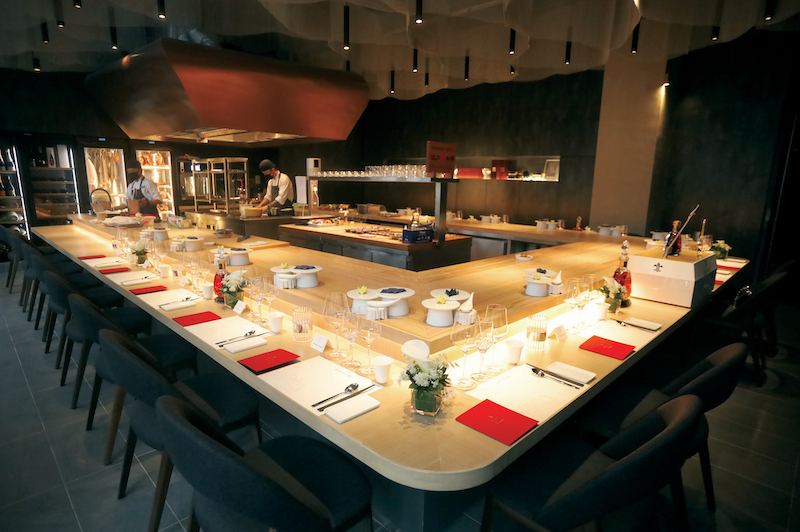
If we were voting, however, the best dish that emerged from the tabletop of fiendishly hot coal embers had to be the A5 ribeye Omi Hime beef. To use a meat of such pedigree already seemed like cheating, but treating the most elite brand of wagyu beef in Japan, with a history that dates back 400 years, requires a special kind of coddling as it comes from heifers that have never given birth. Variations in region affect the cattle’s flavour as much as terroir influences wine grapes. Thus, only skilful manipulation of the grill could elicit the idiosyncrasies of flavour, texture and structure of the exalted beef. A trio of condiments — sambal olek, yuzu kosho (usually made from fresh chillies and fermented with salt) and fleur de sel — helped enliven the flavours of the meat, but you are better off savouring it au naturel, we reckon.
At the end of this feast came a bowl that smothered any remaining hunger pangs: the Imperial Cha-Don. In Japan, a far more humble and homey version is called tamago kake gohan (egg over rice), in which an onsen egg is cracked raw into a bowl of hot white rice, and then fluffed with chopsticks into a comforting wonder. Shin’Labo reversed the order, however, with egg first, rice and, finally, a dusting of roasted gyokuro — the highest rank of Japanese tea leaves — that boasts a concentration of umami similarly found in seaweed. And because this was a cognac appreciation after all, an immoderate amount of caviar was plonked atop the dish to round off the silky smoothness and honeyed notes of the accompanying Louis XIII.
b_0854.jpg
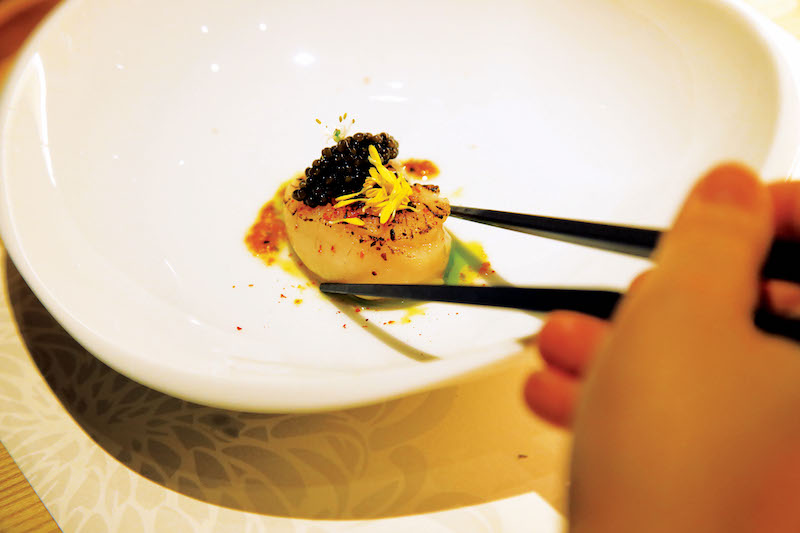
Desserts, at least to us, are a sign of completion rather than the end (because the real postprandial event is a nap, obviously). Shin’Labo composes sweets in calibrated portions to reward you for saving a little room. If the aforementioned dishes pulled out all the stops, its yuzu bergamot parfait glacé built on soba sablé and dotted with Korean persimmon bits was a demonstration of delicious restraint. Carefully tempered with acidity, it primed our tastebuds for a tray of bon bons, Nama choco and almond pralines right after.
As much as Japan is revered for its strict dining customs, there is another side to its people, who chase their cravings into the furthest reaches of their pantry to replicate their love for all things Western. It is one thing to walk away from the Louis XIII dinner at Shin’Labo feeling satisfied; it is another altogether to leave feeling enlightened about the future and promise of yoshoku.
This article first appeared on May 2, 2022 in The Edge Malaysia.


